While a new rover is being readied for the trip to Mars, Curiosity will not be idle. The robot is starting a mile-long journey towards Mount Sharp’s “sulfate-bearing unit”.

Image credits NASA / JPL-Caltech / MSSS.
Under the martian summer sun, Curiosity will be investigating sulfur deposits to gain a glimpse into the alien planet’s history. On Earth, such rocks form through the evaporation of water.
Curiosity has been busy drilling into the clay-rich soils in the Mount Sharp area since 2019, where it was also on the lookout for signs of ancient life and water. By analyzing these clays, researchers can tell whether the planet’s ancient waters could support life.
Now, however, the rover has started making for the mountain’s sulfate bearing unit to get a better understanding of how Martian environments changed as it lost its water and atmosphere.
According to NASA, Curiosity will have to trek around a “vast patch of sand” to avoid getting bogged down. Still, it will have to drive and find the safest paths itself, as there are parts of its journey that we don’t have terrain imagery of.
NASA expects the rover to reach its destination by fall. It could take longer if ground control spots anything interesting they want to take samples of along the way, however.
“Curiosity can’t drive entirely without humans in the loop,” said Matt Gildner, lead rover driver at JPL. “But it does have the ability to make simple decisions along the way to avoid large rocks or risky terrain.”
“It stops if it doesn’t have enough information to complete a drive on its own.”
Depending on the landscape, Curiosity’s can reach between 82 and 328 feet (25 and 100 meters) per hour, NASA adds.









